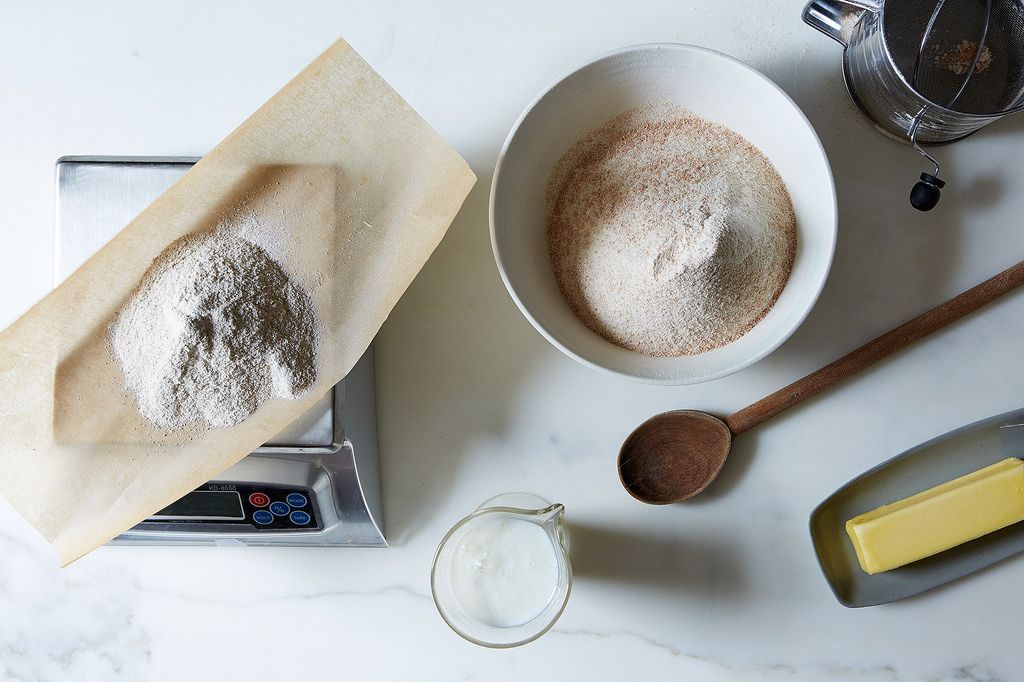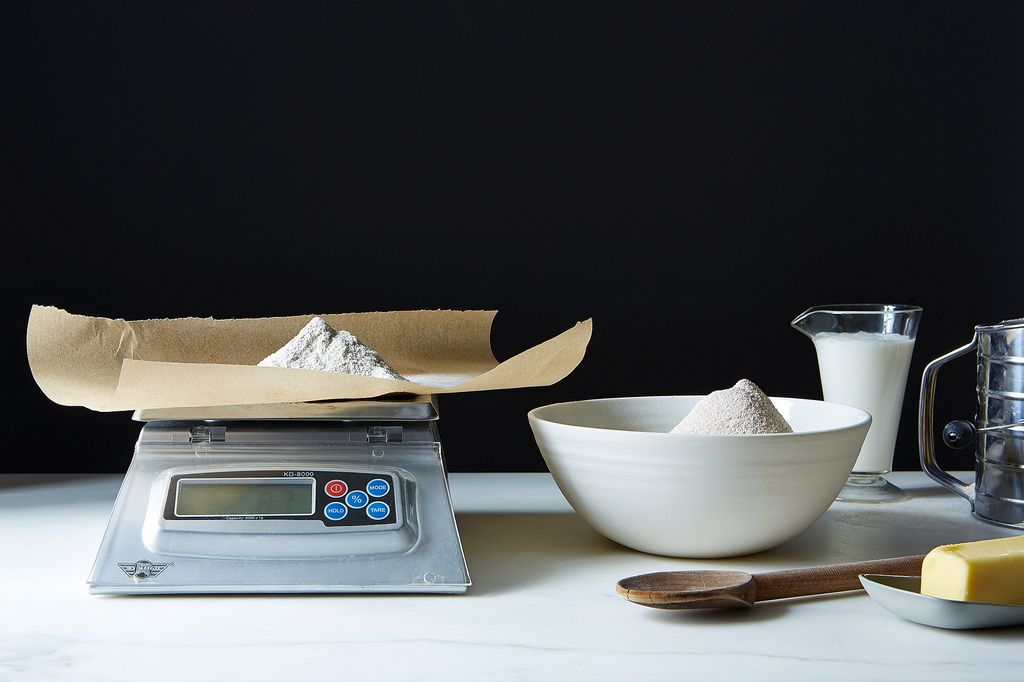
Join The Sandwich Universe co-hosts (and longtime BFFs) Molly Baz and Declan Bond as they dive deep into beloved, iconic sandwiches.
Listen NowPopular on Food52
13 Comments
Sandie
May 11, 2016
I bake gluten-free, and have found that the recipes on King Arthur Flour's website can be made by weight OR volume--each recipe is written this way. I always have great results.
knitchick39
September 18, 2014
What to do when so many recipes only call for cup measurements, not grams? Especially now with non-wheat flours... Appreciate your information, thank you.
1234cake
September 20, 2014
What I do for those, both at home and at work (I'm a professional baker), after I've worked with a new flour a few times and decide I like it, I measure a cup of flour and then weigh it three or four times. I write down the weight for each cup, add them up and take the average. This tends to give me my most consistent results. Make sure to measure each cup of flour with the same method each time as this will effect your accuracy. Hope this helps a bit!
Pamela_in_Tokyo
September 17, 2014
I'm an American living in Japan. I had to learn how to use a scale here. Then when I started using British cookbooks, I really got into scales. I love using a scale. It is so easy to weigh out butter or flour. Plus, you put the bowl on the scale, add some flour, put the scale back to zero, add sugar on top of the flour and still get an accurate reading. There is nothing easier than using a scale!
MJprovence
September 17, 2014
As one who has one foot in the USA and one foot in Europe, flour is my nemesis and the only way I can make things work is by weighing. The system in the USA is medieval.
sarabclever
September 16, 2014
I didn't know this book was coming out--I love baking with unusual flours, I can't wait!
Sam1148
September 16, 2014
I think American home cooks don't uses scales for many reasons:
Okay, I have a old cookbook from grandma for biscuits. What type of flour did she use...why did not work? Why did my sheet cake from the "women's garden club and Mimosa meeting" not work?
Now, these gets into food history and very much Americana...but after the 50's American traveled great distances...thousands of miles and kept on doing that. So Grandmas flour wasn't the flour you got in Georgia for your biscutes when you moved to Seattle.
We're talking lots of miles here. Maybe some Austrialian will chime in here.
Oh..And I use a scale for most things, and I think Americans will use the scale as it's cheap. But recipes are mind-bogglingly crazy when it's made with some Canandain wheat AP as if EVERY ONE LIVES IN BROOKYLN...and the recipes doesn't even mention that heavy weight..and ...well..RANT..RANT.
Okay, I have a old cookbook from grandma for biscuits. What type of flour did she use...why did not work? Why did my sheet cake from the "women's garden club and Mimosa meeting" not work?
Now, these gets into food history and very much Americana...but after the 50's American traveled great distances...thousands of miles and kept on doing that. So Grandmas flour wasn't the flour you got in Georgia for your biscutes when you moved to Seattle.
We're talking lots of miles here. Maybe some Austrialian will chime in here.
Oh..And I use a scale for most things, and I think Americans will use the scale as it's cheap. But recipes are mind-bogglingly crazy when it's made with some Canandain wheat AP as if EVERY ONE LIVES IN BROOKYLN...and the recipes doesn't even mention that heavy weight..and ...well..RANT..RANT.
Jo
September 16, 2014
G'day, here's an Aussie chiming in, ha. The thing I find frustrating with using cups to measure is that it takes an extra step/creates extra mess. Just yesterday, I had to measure out 1/4 cup butter - I had to smoosh butter into a measuring cup, then I had to scrape it out into my mixing bowl. Now if I had measurements, I would have just sat my mixing bowl on my digital scales and placed the exact quantity of butter needed, straight into the mixing bowl. I sometimes get around this by converting the cup measurements to weight in grams, but this sometimes isn't accurate...
Sam1148
September 15, 2014
I love you for bringing up the different weights of flours of even the same types of flours depending on brand/region.
American Flours have different gram weights. Even by region. AP flour is 125g/cup for USDA. But Gold Medal, a brand used in the Southern US, is 130g/cup. While King Arthur claims ALL it's flour is 115g/cup. (?).
http://www.recipesource.com/misc/hints/flour-weights01.html
To give an example this is important, I failed and failed with no-kneed dough using southern AP flour by cup and weight of the recipe developed with Northeastern AP flour.
When I adjusted to weight with 130g/cup of southern AP flour it worked perfectly.
Sigh...even the no kneed dough recipe isn't consistent with 'what flour weights'. Calling for 430g/cup. (for 3 cups) making their 'cup' of flour (bread flour?) 143g/cup...vs 127 and 135 USDA and Gold Medal bread flour.
http://www.sullivanstreetbakery.com/recipes
American Flours have different gram weights. Even by region. AP flour is 125g/cup for USDA. But Gold Medal, a brand used in the Southern US, is 130g/cup. While King Arthur claims ALL it's flour is 115g/cup. (?).
http://www.recipesource.com/misc/hints/flour-weights01.html
To give an example this is important, I failed and failed with no-kneed dough using southern AP flour by cup and weight of the recipe developed with Northeastern AP flour.
When I adjusted to weight with 130g/cup of southern AP flour it worked perfectly.
Sigh...even the no kneed dough recipe isn't consistent with 'what flour weights'. Calling for 430g/cup. (for 3 cups) making their 'cup' of flour (bread flour?) 143g/cup...vs 127 and 135 USDA and Gold Medal bread flour.
http://www.sullivanstreetbakery.com/recipes
Alice M.
September 16, 2014
Well I love you too, for giving these good examples. I hope everyone reads what you just wrote.
FJT
September 15, 2014
Well, as a Brit I've always measured by weight when baking - it just makes more sense as baking requires precision regardless of flour type. I only use recipes that give weight measurements (preferably in grams)! This stood me in good stead when I was diagnosed with celiac disease and had to substitute flours.
Alice M.
September 16, 2014
American home bakers have long been reluctant to use a scale. It's been an uphill battle to sell the idea and meanwhile, until the last few years, not so many cookbooks included weights, so that was further disincentive. More of our best authors are now including ingredient weights, at least in the baking world. Good news for all! It also means we can sell books to you Brits! And of course we like that!
FJT
September 17, 2014
That would be good - I pass up on a lot of cookbooks because of this problem!!!



See what other Food52 readers are saying.